Art World
At the New SoHo Restaurant Manuela, Come For the Food, Stay For the Art
The delicious new restaurant's decor doubles as a group exhibition that features artists from the Hauser & Wirth stable. Artfarm's newly minted CEO Bee Emmott weighs in on Manuela.
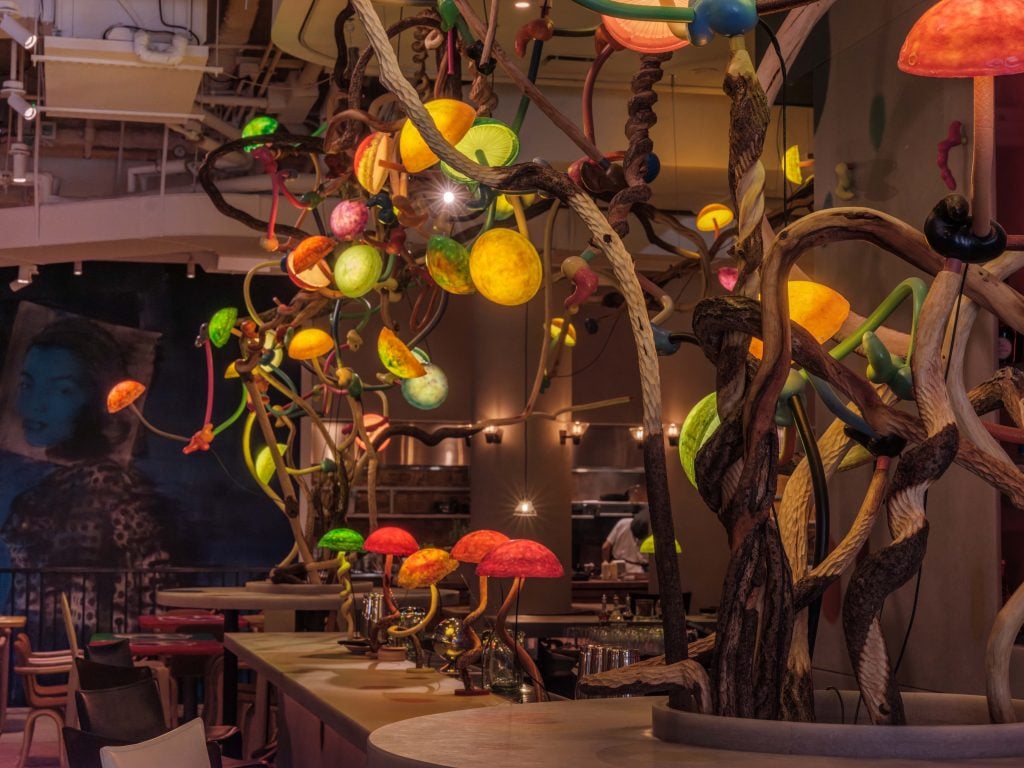
It had been years since someone invited me to a hot new art world–adjacent restaurant in SoHo. But last month I found myself at the soft opening of Manuela. Yes, it is around the corner from Hauser and Wirth’s nascent downtown outpost. The restaurant derives its name from one of the gallery’s co-founders, Manuela Wirth, and is part of the growing portfolio of properties from Artfarm, the hospitality group she founded with her husband Iwan Wirth. Manuela is Artfarm’s first New York outing. It’s a welcome addition to the neighborhood and it certainly lives up to the hype.
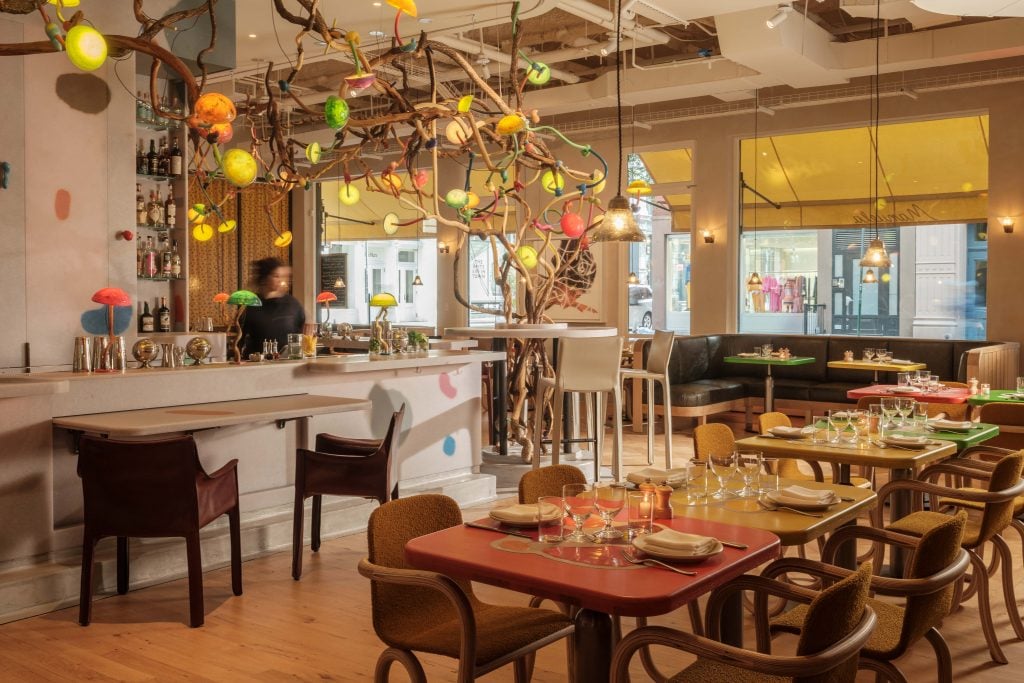
The new eatery Manuela before the lunch rush. Photo: Dave Watts
Immediately upon entering Manuela, even the most blasé local will be enchanted by Mika Rottenberg’s bonkers technorganic bar, composed of recycled plastic, invasive vines, resins, orbs, and mushroom shapes. The primordial behemoth is accentuated with Rottenberg’s mycological chandelier. A giant Louise Bourgeois bronze spider is affixed to one wall and oversees all of the proceedings, including the massive 24-seat Rashid Johnson table that doubles as a functional mosaic—every inch of it, from the top to its base, is covered in shards of mirror and tile.
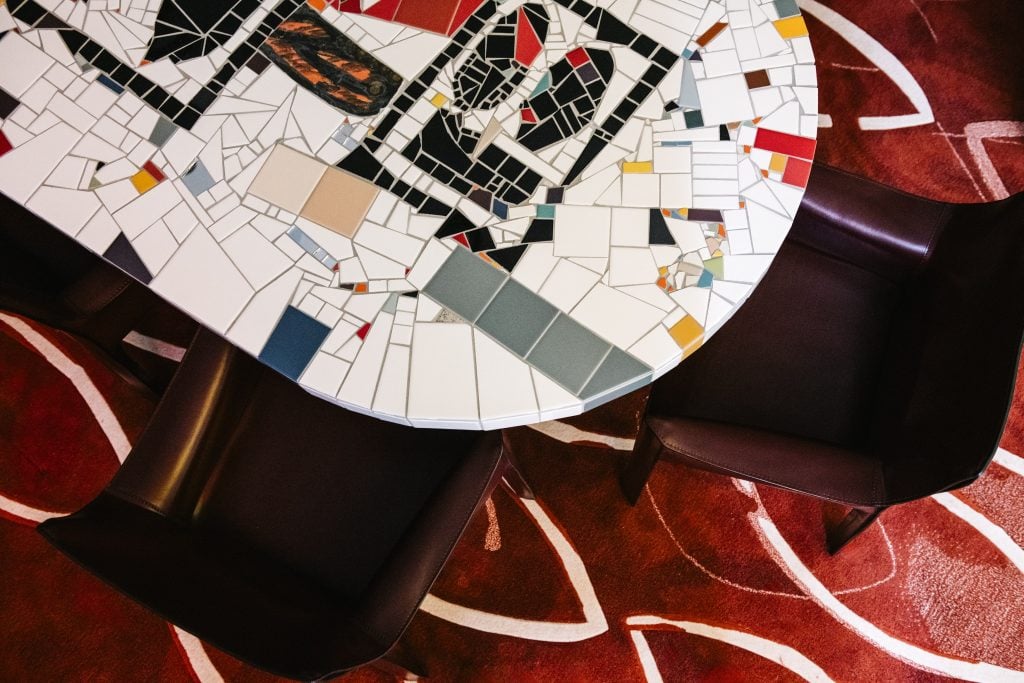
A close-up view of Rashid Johnson’s custom table. Photo: Adrianna Glaviano
My dining party was a very artistic quartet, rounded out by the gallerist Daniel Kapp, the PR and jack of everything else behind-the-scenes Alex Galan of Vidoun, and ceramicist/legend Peter Schlesinger. We were seated underneath a commissioned Rita Ackermann mural depicting three of her bored nymphette avatars sprawled upon a sofa with “What did you do today?” scrawled above.
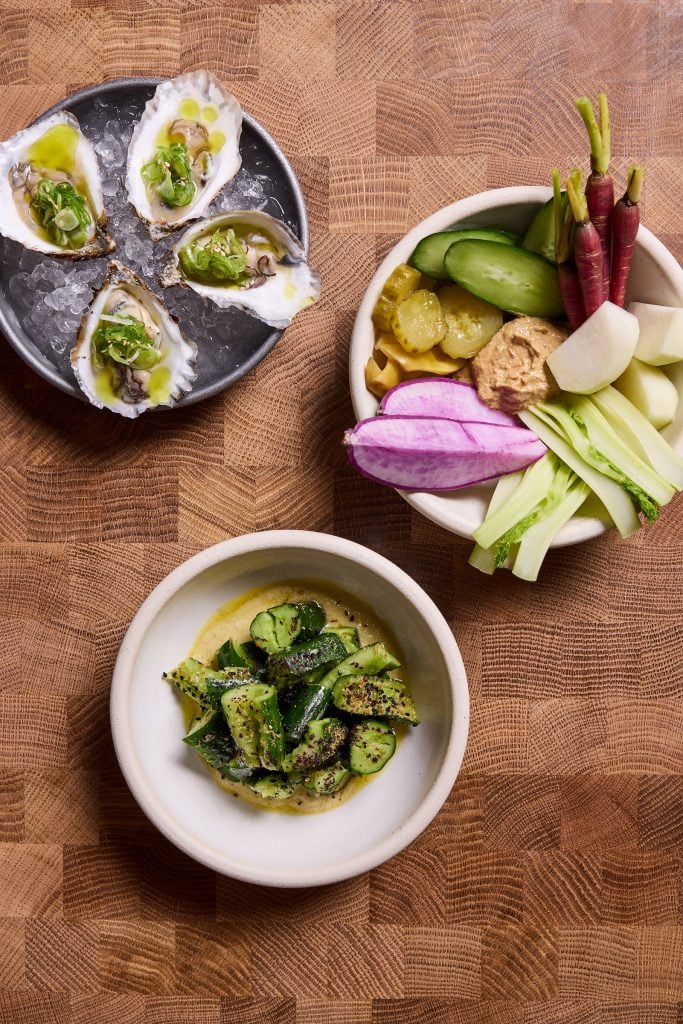
A tri0 of compelling dishes at Manuela. Photo: Kristin Tieg.
“I haven’t stopped thinking about the Rita Ackermann fresco that we were sitting under,” Kapp said. “The space and the presentation of the art—it just felt like time travel to an era of New York from before I lived here. My expectations were blown away. I was not expecting that quality of artwork walking into that restaurant.”
The food was impeccable. Wellfleet oysters with Granny Smith apple vinegar and fig leaf oil. Long Island fluke crudo with pickled pepper and mint. Farm lettuces with aged red wine vinegar radish. A perfectly crispy chicken with Chile de Arbol and lemon. Roasted sunchokes with ricotta and celery. We capped it off with concord grape sorbet with olive oil drizzle. Everything was fresh, light, and so perfect.
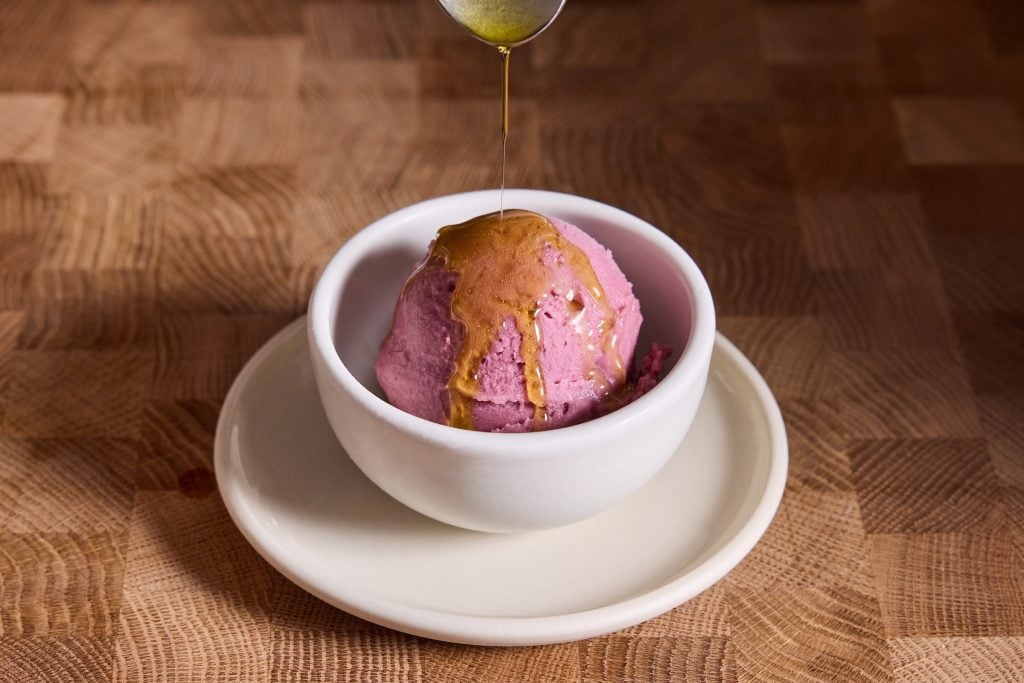
The concord grape sorbet with olive oil drizzle is unforgettable. Photo: Kristin Teig.
In front of us was a wall crammed with art. Some things were easy to discern, the others we guessed haphazardly. Foreseeably, they mostly seemed to be from the Hauser and Wirth stable. A large color Cindy Sherman Untitled Film Still from 1981, a vibrant 2023 Nicolas Party landscape, Arshile Gorky’s 1946 abstract geometric drawing, and two different Andy Warhol black and white photographs of Jean-Michel Basquiat (in one he’s smiling radiantly). Other works were by George Condo, Glenn Ligon, Paul McCarthy, Bruce Nauman… the list of heavy hitters goes on and on. It’s a mighty impressive assemblage.
Judging from my first visit, Manuela aims to be an unfussy hangout with delicious food and a killer curation of contemporary art. Mission accomplished.
Bee Emmott is Artfarm’s current creative director and has been with the company since 2018. In 2025, she will become the CEO. We chatted about the new restaurant.
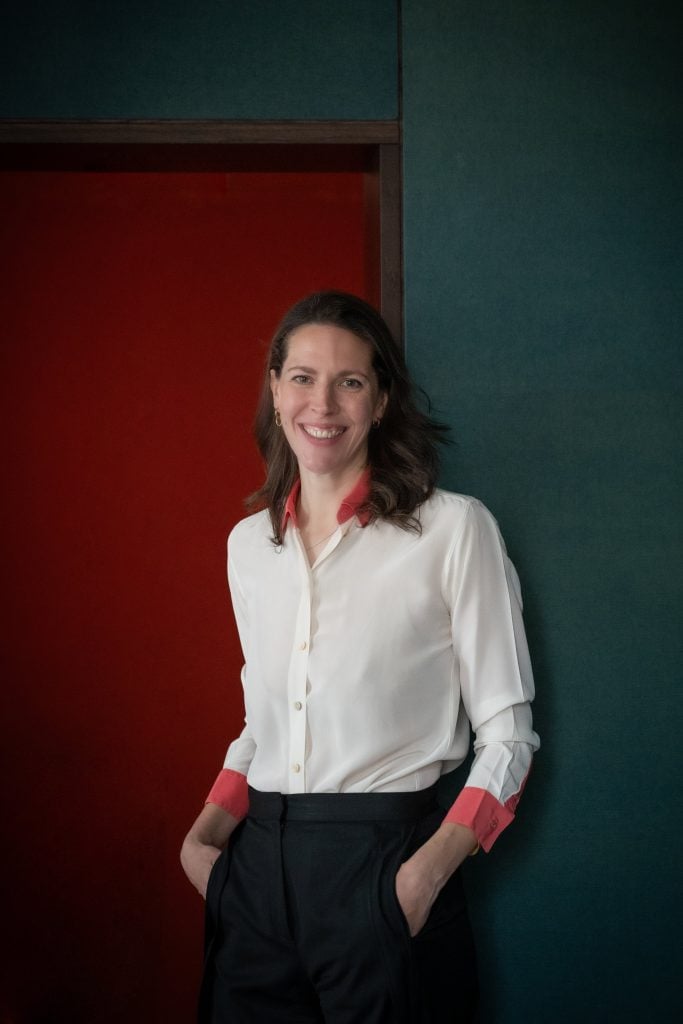
Bee Emmott. Photo: Sim Canetty Clarke, courtesy of Artfarm.
Manuela reminded me of some prior art hangout restaurants, like Match. It seems like it’s been forever since something new has been added. Lucien opened in 1998. Can you tell me about the initial vision?
We knew that art was going to be at the heart of the concept. If we’re talking about the values, it’s named after Manuela Wirth, who is particularly warm and an exceptional host. And I think that is something we have really tried to put at the center of the project.
In terms of vision, we always wanted to work with some of our incredible artists on site-specific art installations. That gives the space something that’s very special and unique. Some of them are functional artworks, like Mika Rottenberg’s bar, Rashid Johnson’s table, and Mary Heilmann’s tables. Art in that context creates such an amazing catalyst for discussion and communication. It creates an amazing space that encourages that connection and quite a special experience.
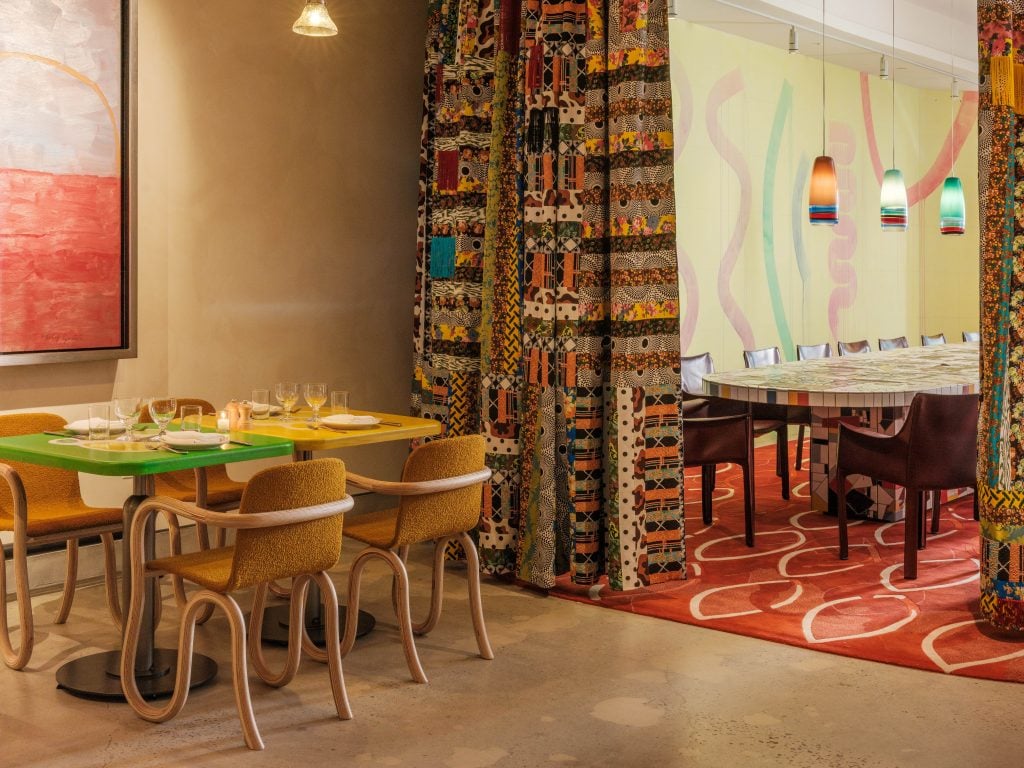
Something that we held onto throughout the whole design process is this idea of art and food and coming together and creating this real convivial, connective place. It’s not a true canteen, but it has some of the principles, this idea of, ‘There’s no better seat in the house.’ All the seats are the same. You can see the kitchen from every seat in that restaurant. It was quite important to make it feel like a democratic space.
One of my favorite components is the Heilmann tables. They’re super colorful without being overly zany and heighten the artworks all around.
A lot of the functional artworks end up being real collaborations. We worked incredibly closely with Mary and her team to make those tables. She obviously has made work from that sort of family of tiles and tables, and she selected colors that she felt really felt right for the space and for the project. And then we worked very closely with a Brooklyn-based manufacturer to make the bespoke tile and with another New York–based fabricator on the actual tables themselves and getting them stained. And obviously it’s very different to make a table that’s not going to be used to making a table that needs to deal with 150 to 200 every night. It leads to its own challenges to try and make these functional artworks that sit in a very different space to a gallery.
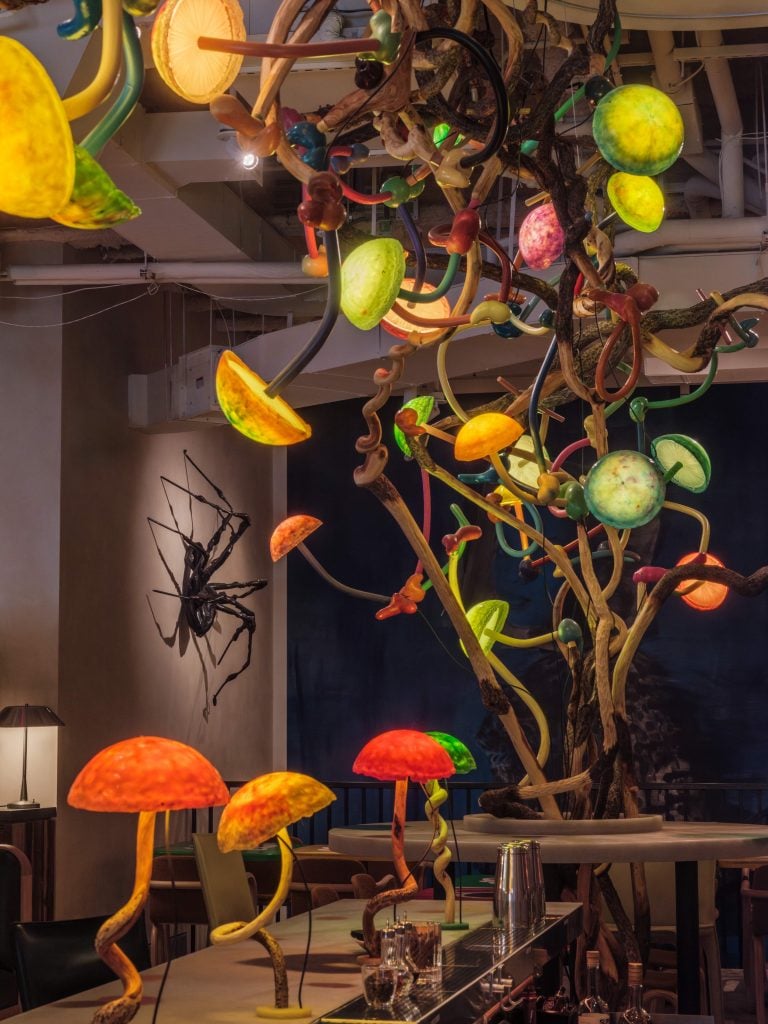
Louise Bourgeois’s spider can be seen slinking in the distance behind Mika Rottenberg’s bar. Photo: Dave Watts.
How did the Mika Rottenberg bar develop?
We spoke with Mika really early on in the process. She’d done some works with those amazing mushroom orb lights. And she works with the invasive vines that she’s cleared in upstate New York where her studio is. So, she had done work in this spirit, and we just saw a real opportunity to do something quite amazing.
We knew we wanted that bar to be the key focal point of the restaurant. Again, working with an artist on a functional bar that needs to serve numerous drinks, martinis, wine, cocktails throughout the night is a very different thing to building an artwork in isolation.
We worked closely with Mika and her team. We worked with electricians, a manufacturer in the UK who developed the recycled plastic. That’s actually over a ton of recycled plastic in the structure of the bar. A number of collaborators helped bring it to life.
Who puts the art curation together? And will it change?
I work along with Hauser and Wirth president Marc Payot. We select each of the artworks and the artists that we work with and we wanted it all to have some kind of connection to New York—the artists had been influenced by New York, or perhaps lived in New York, or somehow connected to the place. That was quite important for us.
It’s quite organic how the works are selected, and I suspect some may change and some may end up staying for longer than others. And it will be quite an organic flow of what changes, what stays put.
We are very interested in places and the stories they have to tell, and particularly places with very rich socioeconomic, cultural, artistic heritage history. SoHo has all of that, in layers and layers.
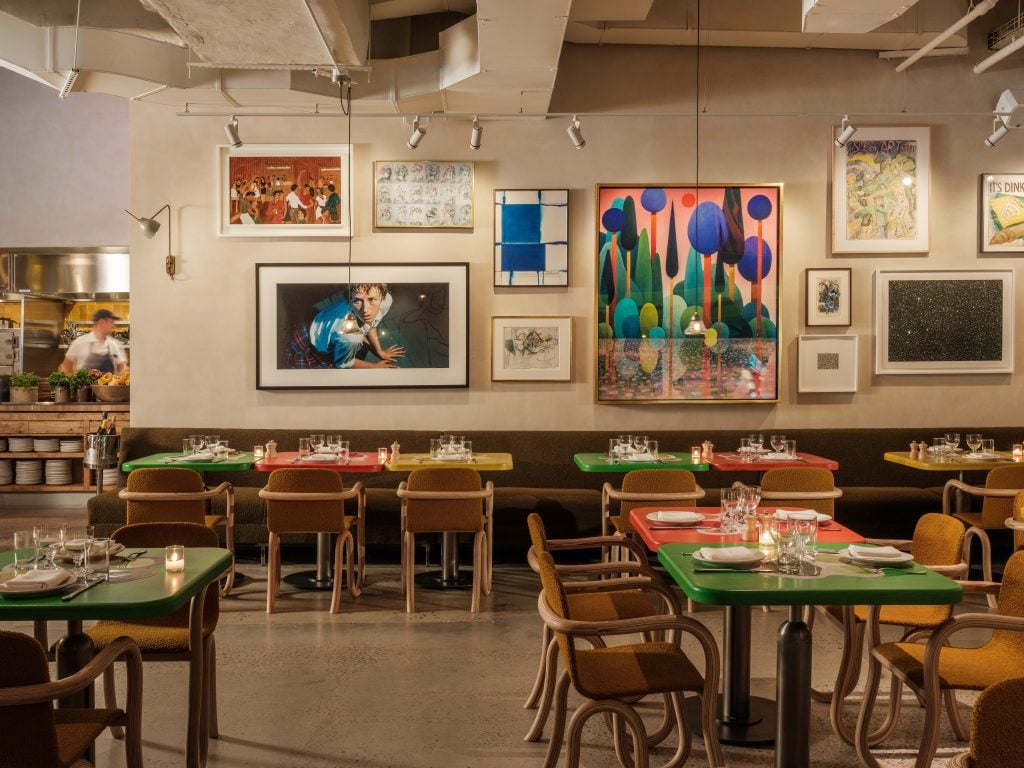
The entire restaurant is covered in art. Photo: Dave Watts.
You’re a fine art and art history graduate. You incorporated that education with a career in a very different realm.
Where do I even start? There is something very compelling about Iwan and Manuela’s vision for Artfarm and what they want to achieve, and I think with a fine art and an art history master’s background, I understand their world. I’ve studied in it, so I understand that side.
But there’s something about what we do at Artfarm that takes that into the day-to-day. Food and drink are for everybody. The art world has a perception of being maybe intimidating or a bit more elitist. Artfarm does something really special in terms of putting art into context, into settings that are deeply accessible, and making art far less intimidating or exposing art to people who might not necessarily see it every day.
And so for me, I’ve just been very attracted to that vision and what we’re trying to achieve. We’re in an exciting new chapter with Manuela. Come back and spread the love and tell everyone to get there. We want it to become everyone’s neighborhood restaurant.
Manuela is located at 130 Prince Street, SoHo. The restaurant is open for dinner Monday-Sunday, lunch Monday-Friday and brunch Saturday and Sunday. Reservations can be made online at manuela-nyc.com and via Resy.





